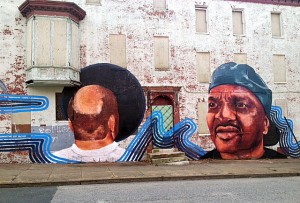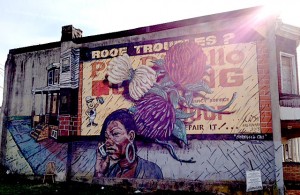When the police cruiser approaches, Nether doesn’t run and he doesn’t hide the bucket of glue at his feet. He used to put up his pieces under cover of darkness, but the police never harassed him, so he switched to daylight hours, which he prefers. It gives him a chance to chat to the neighbors while he works. Some people call what he does vandalism. Nether, nom de guerre of one of Baltimore’s most visible street artists, calls it a “site-specific installation.” The streets are Nether’s gallery, his muse, his subject, his canvas and his artistic statement.
He glances over his shoulder as the police pass, then goes back to his work. “I feel like I should be allowed to do it,” he says. “So I do.”
After a half-hour prowling through West Baltimore in a tired Honda Civic, he had spied a derelict corner grocery with boarded-up windows and flaking red and white paint. A red X on the front door warns firefighters to let it burn. It’s too dilapidated to save. “I kind of like this,” Nether says.
He sizes up the space between the window frame and the hole where the air conditioner used to rest and with a long-handled brush, slathers white flooring glue over the wall. Slowly, he unrolls his latest piece, bottom to top. The topography of a man’s chin, his cheeks, his nose emerges.
“That’s what’s up!” shouts a woman driving by. “That’s a good thing!”
Nether smiles. As a white artist working in mostly black neighborhoods, he hopes people won’t see him as an invader with a bucket of glue. “That’s why something like Wall Hunters works,” he says. “People support it.”
 Wall Hunters is the nonprofit group Nether launched to sharpen Baltimore street artists’ political statement by pointing a finger at the dilapidated buildings where their work appears. Last summer, with a $12,000 grant from an anonymous donor and $4,000 crowd-funded through Indiegogo, he pooled together 16 artists who fanned out across Baltimore’s forgotten neighborhoods to put up street art and raise awareness about the city’s blight of vacant buildings. Each piece includes the property owner’s name and address. A QR code links to Baltimore Slumlord Watch, a website launched by community activist Carol Ott to shame delinquent property owners into taking care of dilapidated properties. Suddenly, Nether and Ott were being featured on NPR and the CBS Evening News, and activists in cities around the country, in places like Richmond, Va., and Columbus, Ohio started launching websites inspired by hers.
Wall Hunters is the nonprofit group Nether launched to sharpen Baltimore street artists’ political statement by pointing a finger at the dilapidated buildings where their work appears. Last summer, with a $12,000 grant from an anonymous donor and $4,000 crowd-funded through Indiegogo, he pooled together 16 artists who fanned out across Baltimore’s forgotten neighborhoods to put up street art and raise awareness about the city’s blight of vacant buildings. Each piece includes the property owner’s name and address. A QR code links to Baltimore Slumlord Watch, a website launched by community activist Carol Ott to shame delinquent property owners into taking care of dilapidated properties. Suddenly, Nether and Ott were being featured on NPR and the CBS Evening News, and activists in cities around the country, in places like Richmond, Va., and Columbus, Ohio started launching websites inspired by hers.
“I honestly believed none of this would matter to anybody,” Ott says.
Baltimore has thousands of abandoned buildings — residents simply call them “vacants” — relics of six decades of industrial decline and white flight. City officials estimate 16,000 vacants line the streets. Ott believes the actual number is three times higher.
Baltimore is a city of row houses, narrow, two-story brick townhomes with stoops or porches, attached one after another, block after block. When left to rot, trees grow up through the stairways, all sorts of urban ills take root inside and neighbors are left to deal with streets declining into desolation. Termites. Rats. Drug dealers. Prostitutes. Homeless people take refuge. Scavengers make off with metal wires and copper pipes. Vandals rip architectural elements off the walls.
Ott lives in Pigtown, a historic neighborhood that takes its name from cavalcades of swine that once scurried daily through the streets en route to slaughterhouses. The birthplace of Babe Ruth, Pigtown, is a racially diverse community of working class and upscale residents — and plenty of vacants in between. She launched Baltimore Slumlord Watch in 2008 after watching an abandoned supermarket lot down the street fill with garbage and feces. When the community association couldn’t fix the problem, she went home from a meeting, pulled out her laptop and started her blog. Embarrassed, the property owner sent out a crew to clean up the mess. Her first battle a victory, Ott kept going, spurred on by people across the city who asked her to feature their neighborhoods and send a simple message to slumlords: clean them up.
“Unless you live in a bubble of dumb, do you not understand that this really does affect other people?” asks Ott. “It basically says that you don’t consider them worth a clean and save neighborhood.”
 Nether and Ott are an unlikely pairing. Nether is 24 years old, with short, brown hair, a nose ring and an armful of tattoos. Six-foot-two and skinny, he has pinpoint eyes in deep sockets, a gravel voice and a laugh like an asphalt compactor. His car sports an Obama bumper sticker. Ott, 45, has straight, blonde hair past her shoulders. She’s five feet tall, stocky, sharp-tongued and quick-witted, a Republican who nurses a maternal affection for the artists who have taken up her cause.
Nether and Ott are an unlikely pairing. Nether is 24 years old, with short, brown hair, a nose ring and an armful of tattoos. Six-foot-two and skinny, he has pinpoint eyes in deep sockets, a gravel voice and a laugh like an asphalt compactor. His car sports an Obama bumper sticker. Ott, 45, has straight, blonde hair past her shoulders. She’s five feet tall, stocky, sharp-tongued and quick-witted, a Republican who nurses a maternal affection for the artists who have taken up her cause.
“People talk about street artists as vandals and these bad kids spray painting mailboxes,” she says. “These are people whose canvases can sell for thousands of dollars. They’re highly accomplished artists, but they have a civil disobedience side to them, which makes their work better in my mind. These aren’t people doing ditzy grandmother watercolors.”
Nether discovered Ott’s website when he was scoping for spots to put up his artwork. Ott discovered Nether when she noticed buildings she had featured were getting a sort-of makeover. The two met for coffee and hatched the idea that became Wall Hunters. Soon, images of soaring doves were taking flight over flaking paint and portraits of neighbors gazed past shattered windows.
 Shawniece Smith is one of those neighbors. She appears on the wall of the vacant next door to her home making the phone call that first brought it to Nether’s attention. “I thought it was wonderful. It was artistic. Not just because the picture is of me, but because it’s probably the last bit of improvement that’s been done to the house in decades,” she says. “What I first felt was, finally somebody was listening to my issues. ”
Shawniece Smith is one of those neighbors. She appears on the wall of the vacant next door to her home making the phone call that first brought it to Nether’s attention. “I thought it was wonderful. It was artistic. Not just because the picture is of me, but because it’s probably the last bit of improvement that’s been done to the house in decades,” she says. “What I first felt was, finally somebody was listening to my issues. ”
A Baltimore native, Smith lives in a tidy row house with wallpapered walls and facing mirrors that reflect the dining room table into infinity. The house next door is one of five vacants on her block. The street faces a cemetery. Her home is freshly painted. The neighbor’s has broken windows, collapsing gutters, crumbling bricks and a falling porch ceiling. Smith blames it for water damage, termites and rats that have invaded the home she shares with her 13-year-old daughter. Fed up with the problem, she called Ott. Ott posted the home on Baltimore Slumlord Watch. A Wall Hunters artist put up the painting on the side. Since then, the QR code linking to the website has vanished twice and the property owners filed a lawsuit against Ott. “They should be focusing on fixing up the property,” Smith says.
As Nether puts up his latest piece on the vacant grocery, the image that takes shape at the end of his brush is one of the few faces on the block at all. Past the grocery sits a vacant row house in faded pink, another in gray concrete, another with vines curving into the space where the door used to be. Two thirds of the homes on the block are abandoned.
“This is our city’s identity,” Nether says. “We shouldn’t be identified by vacant properties. We should be defined by what we did about the vacant properties.”
What Nether does is paste up artwork that will fade with sunlight, peel with rain and crumble to rubble if the walls are ever knocked down. While the pieces stand, they remind passersby that the buildings may be vacant, but these streets are not dead. They are home still to people who live and hope and dream of a more beautiful city to rise from the rubble.


